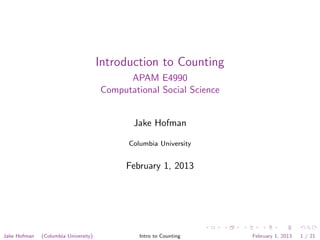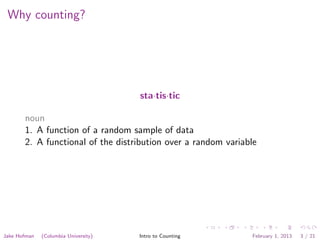Computational Social Science, Lecture 02: An Introduction to Counting
- 1. Introduction to Counting APAM E4990 Computational Social Science Jake Hofman Columbia University February 1, 2013 Jake Hofman (Columbia University) Intro to Counting February 1, 2013 1 / 21
- 2. Why counting? Jake Hofman (Columbia University) Intro to Counting February 1, 2013 2 / 21
- 3. Why counting? sta·tis·tic noun 1. A function of a random sample of data 2. A functional of the distribution over a random variable Jake Hofman (Columbia University) Intro to Counting February 1, 2013 3 / 21
- 4. Why counting? Problem: Traditionally difficult to estimate distributions due to small sample sizes or sparsity Jake Hofman (Columbia University) Intro to Counting February 1, 2013 4 / 21
- 5. Why counting? Potential solution: Sacrifice granularity for precision (e.g., bin observations into larger groups) Jake Hofman (Columbia University) Intro to Counting February 1, 2013 4 / 21
- 6. Why counting? Potential solution: Develop sophisticated methods that generalize well from small samples (e.g., model distributions with parametric forms) Jake Hofman (Columbia University) Intro to Counting February 1, 2013 4 / 21
- 7. Why counting? Jake Hofman (Columbia University) Intro to Counting February 1, 2013 5 / 21
- 8. Why counting? (Partial) solution: When observations are plentiful, simply count and divide to estimate distributions with relative frequencies Jake Hofman (Columbia University) Intro to Counting February 1, 2013 6 / 21
- 9. Why counting? The good: Shift away from sophisticated statistical methods on small samples to simple methods on large samples Jake Hofman (Columbia University) Intro to Counting February 1, 2013 7 / 21
- 10. Why counting? The bad: Even simple methods (e.g., counting) are computationally challenging at large scales Jake Hofman (Columbia University) Intro to Counting February 1, 2013 7 / 21
- 11. Why counting? Claim: Solving the counting problem at scale enables you to investigate many interesting questions in the social sciences Jake Hofman (Columbia University) Intro to Counting February 1, 2013 7 / 21
- 12. Why counting? Jake Hofman (Columbia University) Intro to Counting February 1, 2013 8 / 21
- 13. Learning to count This week: Counting at small/medium scales on a single machine Jake Hofman (Columbia University) Intro to Counting February 1, 2013 9 / 21
- 14. Learning to count This week: Counting at small/medium scales on a single machine Following weeks: Counting at large scales in parallel Jake Hofman (Columbia University) Intro to Counting February 1, 2013 9 / 21
- 15. Counting, the easy way • Load dataset into memory • Arrange observations into groups of interest • Compute distributions and statistics within each group Jake Hofman (Columbia University) Intro to Counting February 1, 2013 10 / 21
- 16. Example: Anatomy of the long tail Dataset Users Items Rating levels Observations Movielens 100K 10K 10 10M Netflix 500K 20K 5 100M Jake Hofman (Columbia University) Intro to Counting February 1, 2013 11 / 21
- 17. Example: Anatomy of the long tail Dataset Users Items Rating levels Observations Movielens 100K 10K 10 10M Netflix 500K 20K 5 100M Jake Hofman (Columbia University) Intro to Counting February 1, 2013 11 / 21
- 18. Example: Movielens 3,000,000 2,000,000 Count 1,000,000 0 1 2 3 4 5 Rating Jake Hofman (Columbia University) Intro to Counting February 1, 2013 12 / 21
- 19. Example: Movielens Density 1 2 3 4 5 Mean Rating by Movie Jake Hofman (Columbia University) Intro to Counting February 1, 2013 13 / 21
- 20. Example: Movielens 100% 75% CDF 50% 25% 0% 0 3,000 6,000 9,000 Movie Rank Jake Hofman (Columbia University) Intro to Counting February 1, 2013 14 / 21
- 21. Example: Movielens Density 10 100 1,000 User eccentricity Jake Hofman (Columbia University) Intro to Counting February 1, 2013 15 / 21
- 22. The group-by operation We estimate conditional distributions by grouping observations by their group identity, or key, and counting values within groups p( y | x1 , x2 , x3 , . . .) value key Jake Hofman (Columbia University) Intro to Counting February 1, 2013 16 / 21
- 23. The group-by operation Generic Group-By for each observation: place observation in bucket for corresponding group for each group: compute function over observations in bucket output group and result Jake Hofman (Columbia University) Intro to Counting February 1, 2013 17 / 21
- 24. The group-by operation Generic Group-By for each observation: place observation in bucket for corresponding group for each group: compute function over observations in bucket output group and result Useful for computing arbitrary within-group statistics when we have required memory (e.g., conditional distribution, median, etc.) Jake Hofman (Columbia University) Intro to Counting February 1, 2013 17 / 21
- 25. The group-by operation Combinable Group-By for each observation: update result for corresponding group, as function of current result and observation for each group: output group and result Jake Hofman (Columbia University) Intro to Counting February 1, 2013 18 / 21
- 26. The group-by operation Combinable Group-By for each observation: update result for corresponding group, as function of current result and observation for each group: output group and result Useful for computing a subset of within-group statistics with a limited memory footprint (e.g., min, mean, max, variance, etc.) Jake Hofman (Columbia University) Intro to Counting February 1, 2013 18 / 21
- 27. Example: Anatomy of the long tail Dataset Users Items Rating levels Observations Movielens 100K 10K 10 10M Netflix 500K 20K 5 100M What do we do when the full dataset exceeds available memory? Jake Hofman (Columbia University) Intro to Counting February 1, 2013 19 / 21
- 28. Example: Anatomy of the long tail Dataset Users Items Rating levels Observations Movielens 100K 10K 10 10M Netflix 500K 20K 5 100M What do we do when the full dataset exceeds available memory? Sampling? Unreliable estimates for rare groups Jake Hofman (Columbia University) Intro to Counting February 1, 2013 19 / 21
- 29. Example: Anatomy of the long tail Dataset Users Items Rating levels Observations Movielens 100K 10K 10 10M Netflix 500K 20K 5 100M What do we do when the full dataset exceeds available memory? Random access from disk? 1000x more storage, but 1000x slower1 1 Numbers every programmer should know Jake Hofman (Columbia University) Intro to Counting February 1, 2013 19 / 21
- 30. Example: Anatomy of the long tail Dataset Users Items Rating levels Observations Movielens 100K 10K 10 10M Netflix 500K 20K 5 100M What do we do when the full dataset exceeds available memory? Streaming? Read data one observation at a time, storing only needed state Jake Hofman (Columbia University) Intro to Counting February 1, 2013 19 / 21
- 31. The group-by operation For arbitrary input data: Memory Scenario Distributions Statistics N Small dataset Yes General V*G Small distributions Yes General G Small # groups No Combinable V Small # outcomes No No 1 Large # both No No N = total number of observations G = number of distinct groups V = largest number of distinct values within group Jake Hofman (Columbia University) Intro to Counting February 1, 2013 20 / 21
- 32. The group-by operation For pre-grouped input data: Memory Scenario Distributions Statistics N Small dataset Yes General V*G Small distributions Yes General G Small # groups No Combinable V Small # outcomes Yes General 1 Large # both No Combinable N = total number of observations G = number of distinct groups V = largest number of distinct values within group Jake Hofman (Columbia University) Intro to Counting February 1, 2013 21 / 21































